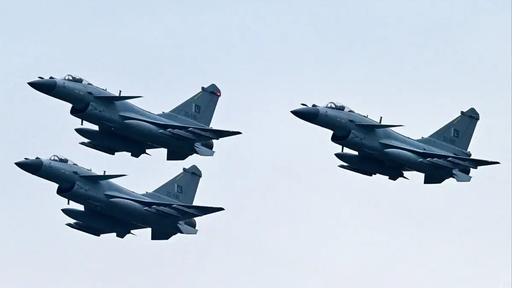China is reportedly fast-tracking the sale of fifth-generation J-35 jets to Islamabad, which will give the Pakistan Air Force (PAF) deep-strike capabilities inside India.
The development comes one month after nuclear-armed Pakistan and India clashed in the biggest air battle since World War II in terms of the number of aircraft involved.
“Intuitively, Pakistan will indeed gain an operational advantage (over India), which might translate into strategic advantages as well, including enhanced deterrence,” Mauro Gilli, an independent defence consultant based in Zurich, tells TRT World.
A stealth fighter like J-35 uses laser-guided bombs to hit targets while avoiding detection by enemy radar through a variety of technologies and a top speed of Mach 2.0, or twice the speed of sound.
The government of Pakistan confirmed in an X post last week that it is acquiring 40 J-35 jets, along with KJ-500 airborne early warning and control aircraft and HQ-19 ballistic missile defence systems, from China.
The purchase of Chinese stealth aircraft by Pakistan can “alter the military balance between two countries” if operated correctly, says Gilli.
“It is reasonable to assume that India would find itself facing a more difficult enemy,” he says, adding that the stealth technology does not mean “complete impunity” given that modern air defence systems remain “very lethal”.

Andreas Rupprecht, a military aviation expert and the author of seven books on Chinese war planes, tells TRT World that there is still time before Chinese J-35s become fully integrated into Pakistan’s air force. Islamabad has received an offer for the stealth aircraft, which does not mean a contract has been signed, he cautions.
However, once the aircraft are delivered and their integration takes place with full operational capability, the fifth-generation fighter will tip the balance of aerial power in Pakistan’s favour, he says.
“India simply doesn't yet have models of this generation (of aircraft), giving Pakistan a real advantage, especially in aerial superiority and deep-strike capabilities,” he says.
In political terms, it will signal that China, the maker of J-35, is willing to support Pakistan proactively without waiting for India to acquire a stealth model, which will take “another decade” at least, he adds.
Pakistan claims it shot down six Indian fighters, including French-made Rafale jets, in the military conflict last month. India initially denied, but its top military official later admitted that Pakistan indeed shot down an unspecified number of fighters during the aerial battle.
The first confirmed combat loss of the sophisticated French aircraft by Pakistan showed Chinese technology was advanced enough to bring down Western fighters.
The Rafale, a 4.5-generation multirole fighter acquired by India in 2020-22, represents the pinnacle of the Indian Air Force’s aerial arsenal. New Delhi paid approximately $8.7 billion to $9.4 billion for 36 Rafale jets at the time.
In April, India signed another deal with France to buy 26 Rafale fighters worth $7.4 billion for its navy.
Pakistan credited its aerial victory against India in the May conflict to 25 J-10C Chinese jets that its air force inducted in 2022. These are state-of-the-art Chinese fighter planes fitted with air-to-air missiles called PL-15, a weapon that China developed for its own exclusive use.
Reports say it was the first time that this long-range missile was used in live combat.

‘Superior’ to India’s upcoming stealth fighter
Pakistan will be the first buyer of the Chinese fifth-generation jet, which China publicly unveiled only last year.
Islamabad will receive the first batch consisting of 30 aircraft possibly by August, six months earlier than the scheduled delivery time of late 2026.
India is currently developing its own fifth-generation stealth fighter designated as the Advanced Medium Combat Aircraft (AMCA).
“It is reasonable to conclude that China’s stealth fighters will be significantly superior to India’s upcoming AMCA for at least some time because of the lead-start of the former,” Gilli says.
Earlier this year, US President Donald Trump announced plans to increase military sales to India, including the potential sale of F-35 stealth jets.
But Indian Foreign Secretary Vikram Misri said afterwards that the F-35 deal was still “at the stage of a proposal”.
Gilli says India may look for acquiring advanced air defence systems to neutralise Pakistan’s stealth advantages.
However, the Russian-made S-400 – a long-range surface-to-air missile system that India uses – complicates potential sales of the US-made F-35 amid US concerns about technological secrets immediately leaking to Russia.
Russia is in the middle of a full-fledged war and its constrained production capacity may limit additional supplies. Furthermore, India’s overreliance on Russian technology could restrict the South Asian nation’s access to other cutting-edge air defence systems from alternative suppliers, Gilli adds.
“India’s reliance on the Russian S-400 makes everything more complicated.”



















